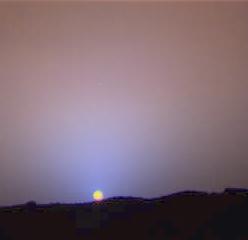This is an image showing a Martian sunset.
JPL/NASA
Mars' Thin Atmosphere
This is image of a Martian sunset illustrates just how thin the Martian atmosphere is.
The terrestrial "blue sky" comes about because molecules of the atmosphere scatter sunlight. In this image, the Martian sky appears pink and a little bit dark at sunset. This is because there are not enough molecules in the atmosphere to scatter the amount of light we are used to seeing on Earth, and also the many rusty-colored dust particles in the atmosphere contribute to the pink color. If you would like to know why the Earth's sky is blue, check the Quickie Question, below.
The thin atmosphere may have something to do with the cold surface temperatures because of the lack of a greenhouse effect, as well as having an affect on the strength of Martian winds.
You might also be interested in:
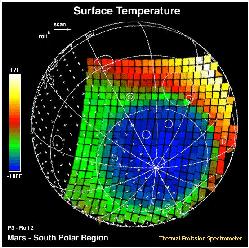
This image shows how cold the surface of Mars can be. The temperature data is from the Mars Global Surveyor mission. The scale to the left shows that purple regions are the coldest, about -170 degrees
...more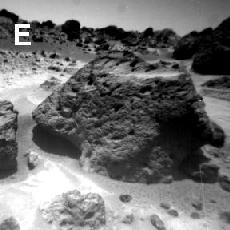
The surface pressure of Mars is about 1/150th that of the surface pressure of the Earth. This means that there are much fewer molecules in the atmosphere. This means that the atmosphere near the surface
...more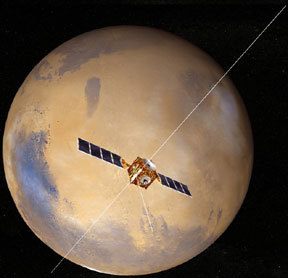
The European Space Agency (ESA) launched a mission to Mars called "Mars Express" in June of 2003. The Mars Express spacecraft has two parts: an orbiter that will circle Mars for at least one Martian year
...more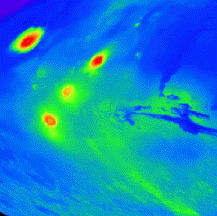
On this map of Mars, the lightly cratered Tharsis Ridge is shown, as well as the heavily cratered Martian highlands (near the bottom of the picture), and Valles Marineris to the right. The volcanoes are
...more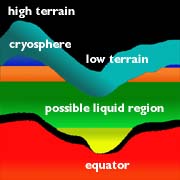
The unusual global geography of Mars helps to explain the fact that water has been drawn from the southern hemisphere to the northern hemisphere of the planet through all of Martian history (that is, from
...more
The Martian geography is one of high altitudes at high southern latitudes and low altitudes at low latitudes. The ground is less frozen at low latitudes because it is warmer and water can evaporate. Thus,
...more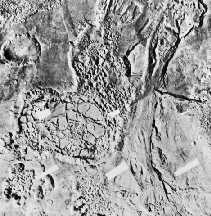
Separate from the Martian outflow channels, or the river valley networks, are large Martian lakes (600 km, or ~1000 miles across) which exhibit evidence of a periodic and catastrophic release of water
...more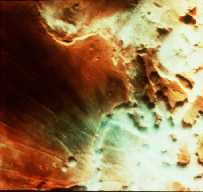
This is an image of fog in a Martian canyon. The presence of fog provides evidence of water, and a water cycle on Mars. More fog has been seen in images returned by Mars Global Surveyor of the south polar
...more
